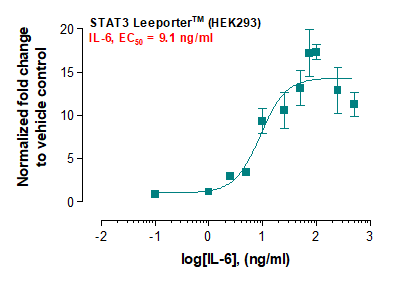Recombinant Mouse Secreted Protein Acidic and Rich in Cysteine/SPARC (C-6His)
Shipping Info:
For estimated delivery dates, please contact us at [email protected]
| Amount : | 50 µg |
| Content : | Lyophilized from a 0.2 µm filtered solution of PBS, pH7.4. |
| Storage condition : | Lyophilized protein should be stored at -20°C, though stable at room temperature for 3 weeks. Reconstituted protein solution can be stored at 4-7°C for 2-7 days. Aliquots of reconstituted samples are stable at -20°C for 3 months. |
| AA sequence : | APQQTEVAEEIVEEETVVEETGVPVGANPVQVEMGEFEDGAEETVEEVVADNPCQNHHCKHGKVCELDESNTPMCVCQDPTSCPAPIGEFEKVCSNDNKTFDSSCHFFATKCTLEGTKKGHKLHLDYIGPCKYIAPCLDSELTEFPLRMRDWLKNVLVTLYERDEGNNLLTEKQKLRVKKIHENEKRLEAGDHPVELLARDFEKNYNMYIFPVHWQFGQLDQHPIDGYLSHTELAPLRAPLIPMEHCTTRFFETCDLDNDKYIALEEWAGCFGIKEQDINKDLVIVDHHHHHH |
Source: Human Cells.
MW :33.6kD.
Recombinant Mouse Secreted Protein Acidic and Rich in Cysteine is produced by our Mammalian expression system and the target gene encoding Ala18-Ile302 is expressed with a 6His tag at the C-terminus. Secreted protein acidic and rich in cysteine (SPARC,BM-40) protein belongs to the family of secreted matricellular proteins with similar domain structure. Mouse SPARC protein involved an N-terminal acidic region that binds calcium, a follistatin domain containing Kazal-like sequences, and a C-terminal extracellular calcium (EC) binding domain with two EF-hand motifs. SPARC is produced by fibroblasts, capillary endothelial cells, platelets, and macrophages, especially in areas of tissue morphogenesis and remodeling. It appears to regulate cell growth through interactions with the extracellular matrix and cytokines. SPARC is expressed at high levels in tissues undergoing morphogenesis, remodeling and wound repair. The activity of SPARC is to modulate cell-cell and cell-matrix interactions, and its de-adhesive and growth inhibitory properties in non-transformed cells have led to studies to assess its role in cancer.
MW :33.6kD.
Recombinant Mouse Secreted Protein Acidic and Rich in Cysteine is produced by our Mammalian expression system and the target gene encoding Ala18-Ile302 is expressed with a 6His tag at the C-terminus. Secreted protein acidic and rich in cysteine (SPARC,BM-40) protein belongs to the family of secreted matricellular proteins with similar domain structure. Mouse SPARC protein involved an N-terminal acidic region that binds calcium, a follistatin domain containing Kazal-like sequences, and a C-terminal extracellular calcium (EC) binding domain with two EF-hand motifs. SPARC is produced by fibroblasts, capillary endothelial cells, platelets, and macrophages, especially in areas of tissue morphogenesis and remodeling. It appears to regulate cell growth through interactions with the extracellular matrix and cytokines. SPARC is expressed at high levels in tissues undergoing morphogenesis, remodeling and wound repair. The activity of SPARC is to modulate cell-cell and cell-matrix interactions, and its de-adhesive and growth inhibitory properties in non-transformed cells have led to studies to assess its role in cancer.
Endotoxin : Less than 0.1 ng/µg (1 IEU/µg) as determined by LAL test.
For Research Use Only. Not for use in diagnostic/therapeutics procedures.
| Subcellular location: | Secreted |
| Post transnational modification: | N-glycosylated. |
| BioGrid: | 203423. 2 interactions. |
|
There are currently no product reviews
|


















.png)












